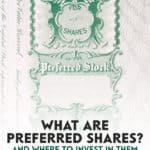Understanding How Preferred Shares Work

Preferred shares are a type of stock that will provide you with a share of ownership in a company. They are listed on a stock market, such as the Toronto Stock Exchange (TSX), the New York Stock Exchange (NYSE), or the Nasdaq, and can be purchased by individual investors through their online stock trading accounts. Preferred shares are not to be confused with common shares, which most investors are familiar with. While both grant the owner equity, there are a number of key differences
How Do Preferred Shares Work?
Preferred shares are an ideal way for a company to raise capital, because they are often purchased in bulk by large institutions, rather than single investors. They are seen as both an equity and income security, because they appreciate in value similar to a common stock while paying a fixed dividend, which is more characteristic of a bond. This fixed dividend generally yields more than a common stock dividend.
Preferred shareholders do not have voting rights, but they do receive preferential treatment when it comes to a company’s distributions. Dividends are paid out prior to common shares and If the company goes under, preferred shareholders have a higher claim on company assets than common shareholders.
The Rights of Preferred Shareholders
Preferred shareholders do not have voting rights, but they have a priority claim on dividends and company assets vs. common shareholders. This makes preferred stock attractive to investors looking to manage volatility in their portfolio.
Preferred Shares vs. Common Shares
There are a few key differences between preferred and common shares. Perhaps the biggest one is that common shareholders have voting rights, whereas preferred shareholders do not. This is important if you are wanting to have a say in the direction of the company you are investing in. In most cases, investors receive one vote for every share they own, and they elect company board members, and vote on major policy decisions.
While preferred shareholders cannot vote, they benefit from preferential treatment of company dividends, and a higher claim on assets if the company was to go under. Preferred dividends are fixed, and offer a higher yield than common share dividends. This provides investors with a predictable source of investment income.
Preferred Shares vs. Bonds
For some, preferred shares act as an alternative to bonds, as the fixed dividend offers a source of predictable income. When held in a non-registered investment account, they are considered more tax efficient than bonds because dividend income is taxed at a lower rate than the interest income that is paid to bond owners. For this reason, it’s usually better to keep bonds inside a registered account, such as a TFSA or RRSP.
Preferred shares are riskier than bonds, because companies pay out bond interest to investors before dividends on preferred and common shares. While bonds offer a lower return than preferred or common shares, they are considered the lowest risk investment of the three.
How to Buy Preferred Shares
Before adding preferred shares to your portfolio, consider your overall investment objective as well as your recommended asset mix, just as you would before buying any other type of investment.
With any type of stock, you assume more risk if you can only buy shares in one or two companies. To properly diversify with preferred stocks, you’ll need to invest in several companies across a variety of industries. Not everyone has enough money to do that.
A perfectly suitable alternative would be to purchase a preferred stock ETF through an online brokerage account like Questrade or Virtual Brokers. While I am in no way making an investment recommendation here, two examples of preferred share ETFs in Canada would be ZPR (BMO S&P/TSX Laddered Preferred Share Index ETF), or CPD (iShares S&P/TSX Canadian Preferred Share Index).
Preferred Stock and ETFs
ETFs are similar to mutual funds in that they hold a large number of underlying stocks, however, they are designed to track a broad market index. For this reason, they are considered passive investments which require less oversight. As a result, the fees charged by an ETF are much lower than a mutual fund. The MER for an ETF can be lower than .10% per year, while it’s not uncommon for an equity mutual fund to have an MER over 2%. ETFs are traded like stock, and can be bought instantly on the market throughout the day.
How Can I Buy Preferred Shares?
Whether it’s via individual stock or an ETF, the easiest way to buy preferred stock is by opening an online discount brokerage account. All of the big Canadian banks have their own online brokerage, or you can choose to go with an independent broker like Questrade. Questrade is our broker of choice here at MapleMoney, mainly due to their low fees. This includes free ETF purchases.
Different Classes of Stock
In addition to preferred and common shares, companies issue different classes of stock. The primary reason they do this is to ensure that certain investors get preferred voting rights. A company may issue both Class A and Class B shares, each with different voting rights. Different share classes are listed separately on the stock exchange, using slightly different stock ticker symbols.
Preferred Stock Characteristics
- Can be purchased on the stock market
- No voting rights
- Lower risk than common stock, higher risk than bonds
- Considered both an income and equity investment
- Usually pays a fixed dividend
- Preferred dividend has a higher claim than common stock dividend
- Best purchased in a non-registered account for tax purposes
Should I Invest In Preferred Shares?
In my opinion, most individual investors do not require preferred shares in their portfolio. That’s because you can get a nice income mix using different types of bonds, and common stock is your best bet as an equity investment. They are riskier than preferred stock, but over the long run they will offer a higher yield. More sophisticated investors, who have the time to fine tune their portfolios, may benefit from adding preferred shares to the mix. You’ll know better than anyone else if you fall into that camp.

